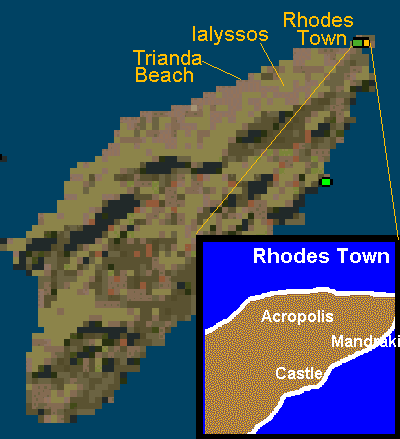| Click on a name to go to that Gallery | |
| History | Galleries | |
|
Rhodes I believe is the fourth or fifth
largest Greek island after
Crete,
Evia,
Lesbos, and possible
Cepholonia. The combination of Rhodes' strategic location, mild climate, and
fertile soil has marked it as a place of conquest for 3000 years. Located where Asia
Minor plummets into the Mediterranean, the people who have controlled Rhodes have
controlled the sea routes into the Middle East.
Earliest documented civilizations on the island were the three allied city-states of Kameiros, Ialyssos and Lindros. Realizing their key towards survival involved unity; they banded together in the 5th century B.C. and made the island Capital Rhodes town. From Rhodes town, the islanders traded with the Persians as well as the Greeks making a nice little profit for themselves. The crafty islanders allied themselves with whoever was the major power at the time and avoided retribution by being shred seamen as well as buying off favors with their trade and wealth. It was during this time of prosperity that the harbor was fortified with 2 mandrakis. The Colossus of Rhodes was built over the two mandraki. The colossus as a giant, 300 ft high bronze statue of Helios, the god of the sun. The statute could be seen for miles and was a mark of power for the islanders. All ships that sailed into the harbor had to sail under the giant statue. The Colossus of Rhodes was so impressive, that it was know as one of the seven wonders of the ancient world. |

|
|
The reason for the statue of Helios was because Rhodes of was the main center of worship for the cult of Helios. It was on Rhodes, located on the outer edges of the Greek empire that the sun (and thus Helios) rose each morning. The statue as much as a political statement as much for worship for ships had to sail under Helios' legs and behold the size of this colossus statue. The statue was an announcement of the power and wealth of the islanders who became known as the Colossians. The Colossians built their city on using grid plan, which the modern town is built on top of. Little is mentioned in my guidebooks about the Roman period except that Rhodes was a major trade center and maritime rival of Rome. Eventually Rhodes fell into the hands of the Romans where it became a backwater. None of my books mentioned the early church on the island to whom Saint Paul wrote not one but two letters to (the Colossians). During the Byzantine period, the island was all but neglected since they had a land route to the Middle East and the island was ceded to Genoa who then gave the island over to the knights of Saint John. The Knights of Saint John were a group of crusaders and hospitallers. Their purpose was to protect pilgrims to the holy land and had a series of castles all along the costal islands. Their main fortress was on Rhodes. After Jerusalem fell to the Turks, they retreated first to Cyprus and then to Rhodes as their main strong hold to the east. They built up the defenses of their castle on the island. When the Knights Templar were suppressed, the Knights Templar passed their possessions and purpose to the Knights of Saint John. The knights took up the fight against the Turks and as a result the island of Rhodes was held siege in 1444 and 1480 but the knights held out, partially from a new improvement to their defenses, St. Nickolas' tower. Finally the town fell in 1522, when a defector betrayed the defenses. The Turks then held the town for about 400 years where they fortified it, kept a standing garrison but otherwise neglected the island. The Italians, in the 1900's took this as an opportunity to move in and siege control of the island, making some "improvements" to the northern end of the town in a neoclassical movement. This included the tacky neo agora. The Italians tried to resurrect the island with tourism but to little avail. The Germans briefly occupied it during World War II and then the British who finally handed it over to the Greeks in 1948. Comments to . | |
